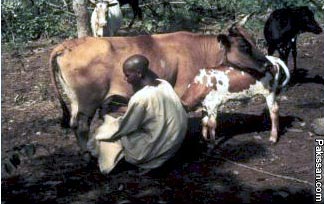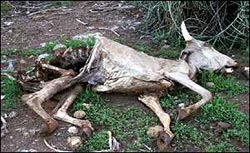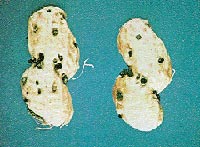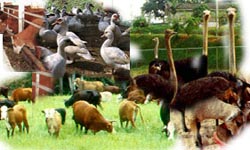|
Participatory
approach for valuable disease surveillance
A workable concept to locate, control and eradicate the
Livestock Diseases
Abstract
The Transboundry animal’s diseases are great threat for the
lives of animals/ livestock in the global village (WORLD). In
those part of the world where TAD (Transboundry Animals
Disease) Especially Rinderpest still exists, eradication will
be achieved by a process of Participatory Disease Surveillance
and intensive vaccination of infected population if found. The
eradication program is in progress in Pakistan with the
coordination of Food & Agriculture Organization (FAO)
of United Nation and European Union (EC). The ministry
of Food, Agriculture and Livestock (MINFAL) and
provincial Livestock departments are in action and
Participatory Disease Surveillance Teams are carrying out PDS
activities in the Targeted villages of their allocated
Districts. From the month of May, 2003 the PDS
team (B) started its activities and visited the targeted
villages (randomly selected by the Data Analyst) of District
Pakpattan, Sahiwal, Toba Tek Singh and Okara till December,
2003. By applying the different tools of Participatory
Epidemiology, the onset of different Livestock diseases was
observed which are shown at next page. The exercise of
Proportional pilling with the local farmers was the actual key
to determine the Livestock diseases prevalence and importance
wise. The PDS Team (B) visited 263 villages of 04
Districts and contacted 4816 Farmers of area while conducting
the 266 farmers meetings in the targeted villages.
During this survey 152 Key Informants were interviewed
for the prevalence of any contagious livestock diseases in the
area/ village. The PDS team (B) visited 02 cattle
markets for the observation of livestock movement within
Districts and Within Provinces. The PDS team (B) also visited
14 specific area/village on the direction/report of TADCO or
District Livestock Officer concerned to observe the Disease
Incidence and collected 13 laboratory samples. The PDS
Team (B) also visited 54 field veterinary institutions
and contacted 176 veterinary staff personals while
conducting awareness meetings.

According to the contacted farmers and Key Informants
interviewed, the Transboundry Animal Diseases are not present
in the Districts covered except Foot and Mouth Disease Which
was observed during the PDS activities by the PDS team (B).
The Rinderpest Disease is not present in the
area/targeted villages of Allocated Districts
Introduction
In the activity of Participatory Disease Surveillance the
participation by the community or target group is the main
aspect.
1. Participation can be defined as a voluntary process by
which people influence or control the decisions that affect
them selves’ by contributing their knowledge, resources and
skills.
2. Participatory approach leads the way we interact with the
peoples and this approach of interaction begin and create /
establish a relation ship / trust between the worker and the
target group of people. While working with Participatory
approach, the actual issues / data or information’s could be
derived from the people/target group.
 3.
Participatory Epidemiology is also a wing of Participatory
approach to locate, control and eradicates any disease from
the particular area. In the Participatory approach the
worker/researcher should be aware of attitude / behavior of
the target group. The attitude / behavior of the target group
or community make the research/surveillance more useful and
valuable, so the active community participation is the main
key for success full Participatory Epidemiology or Disease
Surveillance. 3.
Participatory Epidemiology is also a wing of Participatory
approach to locate, control and eradicates any disease from
the particular area. In the Participatory approach the
worker/researcher should be aware of attitude / behavior of
the target group. The attitude / behavior of the target group
or community make the research/surveillance more useful and
valuable, so the active community participation is the main
key for success full Participatory Epidemiology or Disease
Surveillance.
Methods and Methodology Used
The Participatory Epidemiology is a main tool to observe the
disease incidence in a particular area as the Livestock keeper
always try to get his sick animal recovered with his own or
traditional methods of treatment and the mutual consultation
of farmers leads to the symptoms of those diseases which were
prevailing in that particular area some time.
 The
PDS Teams trained in Participatory Disease Surveillance
technique applied the tools of Participatory Disease
Surveillance to get a valuable Participatory appraisal. The
active participation of local farmers/ livestock owners made
the activity more effective and authenticated. To get more and
active participation the meeting time and place was the main
consideration of the PDS Team. In every village / area the
Participatory Epidemiology tools were applied with flexible
manner according to the local situation so that the correct
information/ data can be collected / complied. Following main
activities were performed in the targeted villages / area as
methodology for Participatory Disease Surveillance. The
PDS Teams trained in Participatory Disease Surveillance
technique applied the tools of Participatory Disease
Surveillance to get a valuable Participatory appraisal. The
active participation of local farmers/ livestock owners made
the activity more effective and authenticated. To get more and
active participation the meeting time and place was the main
consideration of the PDS Team. In every village / area the
Participatory Epidemiology tools were applied with flexible
manner according to the local situation so that the correct
information/ data can be collected / complied. Following main
activities were performed in the targeted villages / area as
methodology for Participatory Disease Surveillance.
• Conduction of farmers meetings
• Proportional Pilling
• Mapping of the village / area
• Seasonal Calendar of livestock diseases
• Interviewing the Key Informants
• Observing the health status of existing livestock
• Collection of samples for final laboratory diagnosis
• Visiting the Veterinary Institutions
• Contacting with the field veterinary staff
• Visiting the local cattle markets
• Visiting the commercial Dairy farms
• Visiting the cattle colonies
Proportional Pilling / Farmers Meeting
The Participatory Disease Surveillance Teams (PDS) consisting
of 3 members working as facilitator, moderator and recorder to
carry out the PDS activities in the target area starts its
work with work plan. The map of the area is more useful for
the planning of activities such as proportional pilling and
farmers meetings.
The farmers gathering depend upon the time, place, local
politics, conflicts and weather. The primary introduction of
PDS Team builds a structure of confidence which leads to a
valuable discussion of Livestock Diseases prevailing in the
area. The use of pictures, charts and banners for the
identification of different diseases makes the things easier
for the farmers to participate in the proportional pilling
/scoring of
 Livestock
Diseases prevalence and importance wise. Livestock
Diseases prevalence and importance wise.
The use of different types of things such as small stones,
tablets, seeds, and beans etc for pilling creates the interest
in the exercise. Generally the farmer/livestock holder enjoys
the talk/discussion for his livestock health and production,
and it’s the secret of a successful Disease Surveillance.
Mapping
Mapping is also a very useful method to get the actual
information from the farmers regarding their livestock
movement and grazing area. This activity involves the farmers
physically to create a map showing natural resources, such as
canal, river, forest, grazing area, ponds and cattle trespass.
In this activity both literate and non-literate people can
contribute to draw a map on the ground with an ordinary stick.
The mapping exercise and the map made by the farmers can be
used for the discussion as well as for participatory analysis.
The mapping method is also useful for follow up questioning
and visiting the risk area.
Seasonal Calendar
The onset of different livestock diseases in the particular
area can be searched out through open ended questions to the
farmers or Key informants during meeting /interviews. Seasonal
variations and its perceptions of occurrence could be defined
by the farmers by making seasonal calendar. The farmer has
indigenous knowledge regarding the prevalence of disease in
that area and by making the seasonal calendar on the ground
the worker/researcher can identify the actual onset of
diseases.
 To
get the actual situation of disease, the worker/researcher
should know or understand the traditional/local names of
season and diseases. While interviewing or meeting with the
farmer, the information regarding the local names can be got
for reference. The use of pictures for seasons and diseases
are necessary, so that the farmers can understand the disease
while drawing seasonal calendar on the ground. By applying
/constructing a one year time line on the ground and placing
the picture of disease one by one, the onset of disease can be
scored with small stones under each season. In this way the
seasonal calendar grow slowly showing all information of
diseases prevalence in particular area. The farmer can explain
the interesting aspects of diagram / seasonal calendar on the
questions of worker/researcher and by using the probing
questions the actual situation/data could be derived from the
diagram made by the farmers. To
get the actual situation of disease, the worker/researcher
should know or understand the traditional/local names of
season and diseases. While interviewing or meeting with the
farmer, the information regarding the local names can be got
for reference. The use of pictures for seasons and diseases
are necessary, so that the farmers can understand the disease
while drawing seasonal calendar on the ground. By applying
/constructing a one year time line on the ground and placing
the picture of disease one by one, the onset of disease can be
scored with small stones under each season. In this way the
seasonal calendar grow slowly showing all information of
diseases prevalence in particular area. The farmer can explain
the interesting aspects of diagram / seasonal calendar on the
questions of worker/researcher and by using the probing
questions the actual situation/data could be derived from the
diagram made by the farmers.
PDS Impact on the farmer
The PDS Team during its activities interacts with the field
veterinary staff and livestock owners/farmers. Being the
owners of animals, the farmers are the main source of
Information regarding livestock diseases as its prevalence and
importance in their area. The working field veterinary staff
is also a good source of disease reporting. During this
study/surveillance following points regarding social behavior
were observed.
• EXPECTATIONS
• FEAR
• DEMAND
Response
1. While seeing the Government staff on vehicle, the farmers
of that village expects some common facilities.
2. At first instance the farmers hesitate to interact with the
team.
3. After the introduction by PDS team, having the
apprehensions of tax in his mind, firstly he avoids to give
the exact information about him and his livestock.
4. After discussion regarding the livestock diseases, the
farmers gain the confidence and starts interacting with the
PDS team.
5. During discussion, after perceiving the team’s aims /
objectives, he actively participates.
6. While pilling, mapping and making seasonal calendar of
livestock diseases, the farmers elaborates the prevalence and
importance of livestock diseases.
7. After pilling and mapping etc, he demand from PDS team, a
comprehensive lecture on important prevalent livestock
diseases.
8. Some farmers also demand medicine, vaccine etc free of cost
however the other participants of meeting condemn this demand
having the clear concept of PDS activities.
9. The farmers hesitate to inform, about the contagious
diseases, in the presence of concerned field veterinary staff.
Conclusions
• Tools of Participatory Epidemiology are quite helpful
to evaluate the disease situation in the village/area. The
interest of the farmers/participants was very much appreciable
while applying the exercise of mapping, seasonal calendar and
proportional pilling.
• Working with the beans/seeds for the exercise of
proportional pilling is very much effective when all the
representatives of all groups living in the village are
present and participating in the exercise.
• A reasonable farmers gathering (15-20) in one meeting
is more effective having discussion on every aspects.
• The management and feeding aspects are being ignored
by the farmers causing metabolic disorders in their livestock.
• The livestock diseases such as Hemoglobin urea,
Mastitis and prolapsed uterus are main concern for the
farmers.
• The livestock holders of the area/village are well
aware about the severity of Hemorrhagic Septicemia and they
are vaccinating their animals.
• The Foot and Mouth disease was prevailing in the
area/villages 3 months back but the farmers have no fear about
the disease as the disease is not causing mortality in the
livestock.
• The name of Rinderpest Disease is new for the farmers
of area/villages, but the symptoms especially Diarrhea
described by the PDS Team leads to think about the PPR in
sheep and Johnes disease in buffalos and cattle.
• The old men of the area/village and the farmer which
are selling their animals to the traders of Karachi were some
time agreed with the symptoms of RP but in Karachi 5-10 year
back.
For more Detail:
Dr
Muhammad Rasheed
In charge PDS Team (B)
Phone: 0441-50305
Email: vetdr@swl.paknet.com.pk |
Pakissan.com;
|